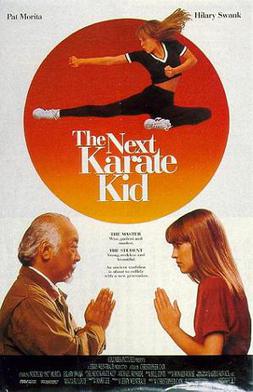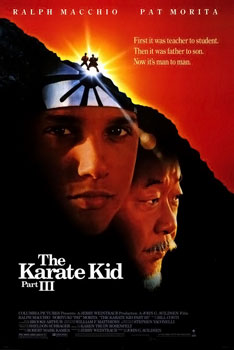
Karate (空手), also karate-do, is a martial art developed in the Ryukyu Kingdom. It developed from the indigenous Ryukyuan martial arts under the influence of Chinese martial arts. While modern karate is primarily a striking art that uses punches and kicks, traditional karate training also employs throwing and joint locking techniques. A karate practitioner is called a karate-ka (空手家).

The Karate Kid is a 1984 American martial arts drama film written by Robert Mark Kamen and directed by John G. Avildsen. It is the first installment in the Karate Kid franchise, and stars Ralph Macchio, Pat Morita, Elisabeth Shue, and William Zabka. The Karate Kid follows the story of Daniel LaRusso (Macchio), an Italian-American teenager from New Jersey who moves with his widowed mother to the Reseda neighborhood of Los Angeles. There, LaRusso encounters harassment from his new bullies, one of whom is Johnny Lawrence (Zabka), the ex-boyfriend of LaRusso's love interest, Ali Mills (Shue). LaRusso is taught karate by a handyman and war veteran named Mr. Miyagi (Morita) to help LaRusso defend himself and compete in a karate tournament against his bullies.

Shotokan is a style of karate, developed from various martial arts by Gichin Funakoshi (1868–1957) and his son Gigo (Yoshitaka) Funakoshi (1906–1945). Gichin Funakoshi was born in Okinawa and is widely credited with popularizing "karate do" through a series of public demonstrations, and by promoting the development of university karate clubs, including those at Keio, Waseda, Hitotsubashi (Shodai), Takushoku, Chuo, Gakushuin, and Hosei.

Gōjū-ryū (剛柔流), Japanese for "hard-soft style", is one of the main traditional Okinawa styles of karate, featuring a combination of hard and soft techniques.

Noriyuki "Pat" Morita was an American actor and comedian. He began his career as a stand-up comedian, before becoming known to television audiences for his recurring role as diner owner Matsuo "Arnold" Takahashi on the sitcom series Happy Days (1975-83). He was subsequently nominated for an Academy Award for Best Supporting Actor for his portrayal of martial arts mentor Mr. Miyagi in The Karate Kid (1984), which would be the first of a media franchise in which Morita was the central player.

Kill and Kill Again is a 1981 action film directed by Ivan Hall. The film stars James Ryan as Steve Chase who is hired to save the scientist Horatio Kane, who has been kidnapped by the villain Marduk. Chase gathers together a team of mercenaries who find their way to the villain's stronghold and then find themselves fighting for their lives as they are captured.

The Next Karate Kid is a 1994 American martial arts drama film directed by Christopher Cain, produced by Jerry Weintraub, and written by Mark Lee. It serves as the fourth installment in the Karate Kid franchise, following The Karate Kid Part III (1989). It stars Hilary Swank as Julie Pierce, and Pat Morita reprising his role as Mr. Miyagi from the first three films, with Constance Towers, Chris Conrad, Michael Cavalieri, Walton Goggins, and Michael Ironside in supporting roles. Bill Conti, the composer of the previous films, returned to score the fourth. It is the first film in the series not to feature Ralph Macchio in the lead role as Daniel LaRusso.

Nariyoshi Miyagi, better known as Mr. Miyagi, is a fictional character portrayed by Pat Morita who appeared in The Karate Kid (1984), The Karate Kid Part II (1986), The Karate Kid Part III (1989), and The Next Karate Kid (1994). A wise, Okinawan-born karate master, he mentors Daniel LaRusso in the first three films (1984–1989) and Julie Pierce in the fourth one (1994).
The elderly martial arts master is a mentor/teacher stock character in fiction, especially Wuxia, Chanbara, and other martial arts films. Typically an East Asian male, he is a near-invincible master of the martial arts, despite being advanced in age and presumably having a decrease in physical strength. Often he possesses the rank of sensei and is referred to as such by his student. The elderly master most often teaches either generic kung fu or an exotic style specific to the fictional period. During the films, the master often becomes close with his students, with the master becoming a guardian figure to the trainees, who are, in turn, looked upon as the master's children. Usually, when the master is captured or killed, or an iconic portrait of the deceased master has been desecrated by some villains, the students will take it upon themselves to rescue or avenge their master.

The Karate Kid Part III is a 1989 American martial arts drama film, the third entry in the Karate Kid franchise and a sequel to The Karate Kid Part II (1986). It stars Ralph Macchio, Pat Morita, Robyn Lively, and Thomas Ian Griffith in his film debut. As was the case with the first two films in the series, it was directed by John G. Avildsen and written by Robert Mark Kamen, with stunts choreographed by Pat E. Johnson and music composed by Bill Conti. In the film, the returning John Kreese, with the help of his former army friend Terry Silver, attempts to gain revenge on Daniel and Mr. Miyagi which involves recruiting a ruthless martial artist and harming their relationship.

Fighter in the Wind is a 2004 South Korean martial arts action film. It is based on the Japanese book Karate Baka Ichidai which is a fictionalized account of karate competitor Choi Yeung-Eui who went to Japan during World War II to become a fighter pilot but found a very different path instead. He changed his name to Masutatsu Oyama (大山倍達) and went across the country, defeating martial artists one after another. This film concentrates on the period when he is still young, and developing his famous karate style, Kyokushin. The film was the seventh highest grossing Korean film of 2004 with 2,346,446 admissions sold nationwide.
"The Fight" is the sixth episode of the second season of the television series The Office and the show's twelfth episode overall. It was written by Gene Stupnitsky and Lee Eisenberg and directed by Ken Kwapis. It originally aired on November 1, 2005, on NBC. "The Fight" guest starred Lance Krall, who played the part of Dwight's sensei, Ira.
This article is about the Australian mixed martial artist. For the Florida political figure, see Samuel Greco.
Jerry Smith is a former professional full-contact fighting coach, as well as co-founder of the Black Karate Federation (BKF) and founder of The Five-Level Method/Shorin-Ju Kenpo.

Karateka is a 1984 martial arts action game for the Apple II by Jordan Mechner. It is his first published game and was created while he was attending Yale University. The game was published in North America by Broderbund and in Europe by Ariolasoft. Along with Karate Champ and Yie Ar Kung-Fu, Karateka is one of the earliest martial arts fighting games. It was inspired by Japanese culture and by early Disney animated films and silent pictures. An influential game of its era, it was one of the first to use cinematic storytelling and sound design, and rotoscoped animation.

Willie Williams was an American karateka, mixed martial artist and professional wrestler.
Norman Robinson is a South African master of Shotokan karate. He and Stan Schmidt were the first practitioners of Shotokan karate in South Africa and they instigated the establishment of the South African branch of the Japan Karate Association (JKA) in 1965 and popularized the art across the country. In 1970 he was one of the first westerners to be invited into the JKA's famous Instructor Class in the Tokyo Honbu dojo, the invitation having been offered by Masatoshi Nakayama himself. Latterly, he established Japan Karate Shotokai South Africa, having remained loyal to Tetsuhiko Asai after Asai established Japan Karate Shotokai. Norman Robinson is also a distinguished student of Judo, holding a 7th dan in that art, and is also known for his acting roles in several martial arts films. His son, Mark Robinson is multi-disciplinary martial artist and powerlifter.
Stan Schmidt was a South African master of Shotokan karate. Along with others, such as Norman Robinson, he was an early practitioner of Shotokan karate in South Africa and his establishment of the South African branch of the Japan Karate Association (JKA) in 1965 after training in Japan, along with his subsequent promotion of the art in South Africa, earned him the appellation of 'The Father of South African Karate'. In 1963, he was one of the first westerners to be invited into the JKA's famous Instructor Class in the Tokyo Honbu dojo and he was later one of four non-Japanese karateka to sit on the JKA's international Shihankai. He was also the first non-Japanese karateka to attain 7th dan from the JKA and also the first to attain 8th dan. Today, he is the highest ranking non-Japanese karate master of that organization. He is also known for his acting roles in several martial arts films of the 1970s and 1980s.

Cobra Kai: The Karate Kid Saga Continues is a 2020 side-scrolling beat 'em-up game based on the American streaming television series Cobra Kai, which in turn is based on the film franchise The Karate Kid. Developed by Flux Games and published by GameMill Entertainment in North America and Maximum Games in Europe, it was released for Nintendo Switch, PlayStation 4, and Xbox One on October 27, 2020, and for Windows on January 5, 2021. The Nintendo Switch version was released in Europe on November 24, 2020. Ralph Macchio, William Zabka, Jacob Bertrand, and Gianni DeCenzo reprise their roles as Daniel LaRusso, Johnny Lawrence, Eli "Hawk" Moskowitz, and Demetri Alexopoulos respectively, while the rest of the other characters are voiced by different actors. A sequel developed by Flux Games and published by GameMill Entertainment titled Cobra Kai 2: Dojos Rising was released on November 8, 2022 for Nintendo Switch, PlayStation 4, PlayStation 5, Windows via Steam, Xbox One, and Xbox Series X/S.













